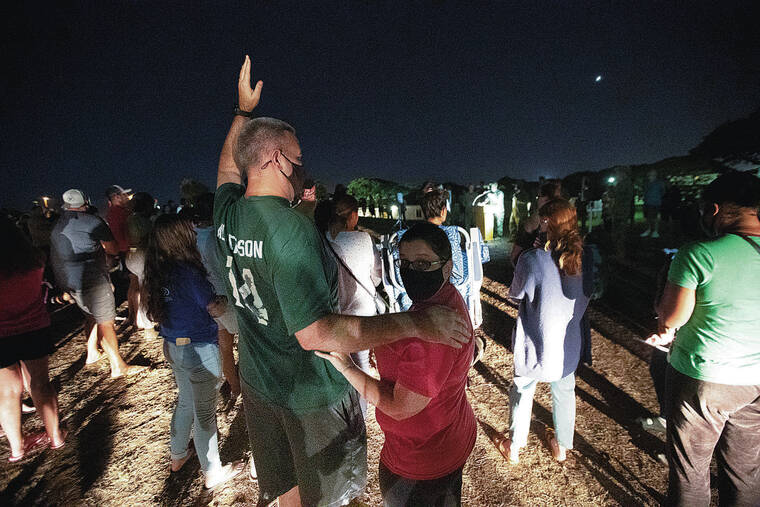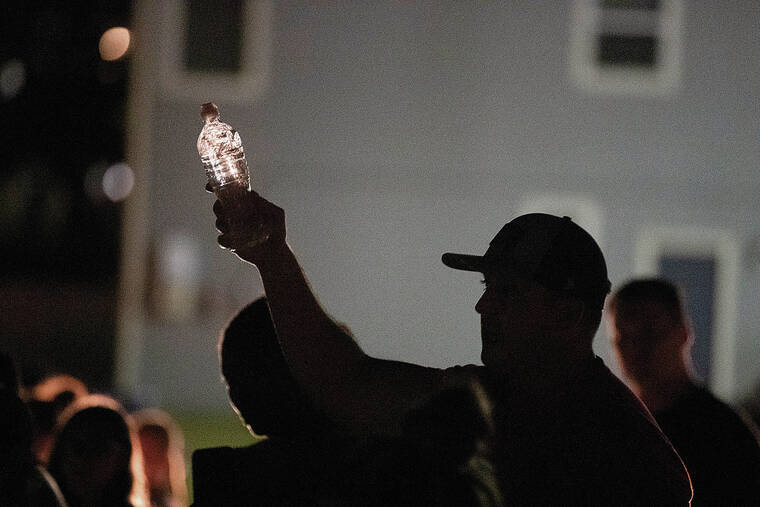The Navy on Sunday quietly shut down its Red Hill shaft, which pulls water from the aquifer below, as military families around Joint Base Pearl Harbor-Hickam began to call in complaints about a fuel or chemical smell coming from their tap water.
The Red Hill well is just 3,000 feet makai of the Navy’s troubled Red Hill Underground Fuel Storage Facility, which contains 20 massive underground fuel tanks. A history of leaks from the World War II-era facility has raised fears in recent years that fuel will contaminate the aquifer, polluting not just the Navy’s water supply system, but a major source of drinking water for southern Oahu.
A spokeswoman for the Navy told the Honolulu Star-Advertiser on Tuesday that the Red Hill shaft was shut down out of an “abundance of caution.”
But Ernie Lau, manager and chief engineer of the
Honolulu Board of Water Supply, which is tasked with keeping Oahu’s drinking water safe, said it raises red flags.
“That causes more questions for us because we have been concerned about the risk of the Red Hill fuel facility to the aquifer, to water resources in that area, for seven, going on eight years now,” said Lau. “If they think the Red Hill shaft is the source of the problem, then we want to understand why. Does it pose a risk potentially to our Board of Water Supply sources around that area?”
Lau said that the Board of Water Supply needs access to information and data as soon as possible to assess the potential threat.
“It’s extremely troubling,” said Lau.
The Navy and state Department of Health have been flooded with calls since Sunday from residents who receive their water from the Navy’s Joint Base Pearl Harbor-Hickam water system. Residents have complained Opens in a new tab about an odor of fuel or chemicals coming from their tap water, and some people say they have been experiencing headaches, stomach pains and skin rashes in recent days. They worry that the water has been making them sick.
Officials at three area schools — Holy Family Catholic Academy, Red Hill Elementary and Nimitz Elementary — also detected a fuel odor coming from their water Monday. Kathleen Ho, deputy director of environmental health for DOH, said that an inspector with the Health Department also detected a fuel odor coming from the water at the elementary schools.
DOH says that the water testing has so far been inconclusive. While the tests have not detected contamination, water samples have been sent to a California
lab that can provide more sensitive and contaminant-specific results.
In the meantime DOH has advised that all Navy system water users avoid using tap water for drinking, cooking and brushing their teeth. If they smell a fuel odor, they should also avoid using the water for bathing, dish-washing and laundry.
Ho said that about 93,000 people in the Pearl Harbor area get water from the Navy’s water system, which is separate from the Honolulu Board of Water Supply’s system, which provides water to the majority of Oahu. So far, there have been no signs that the water supplied by the Board of Water Supply is affected. But Lau said he would increase testing from quarterly to monthly.
The Navy’s Red Hill well typically supplies about one-quarter of the potable water to the Navy’s Pearl Harbor water system, according to a 2010 report prepared for the Navy.
Lydia Robertson, a spokeswoman for Navy Region Hawaii, said that since shutting down the Red Hill shaft, the Navy has been relying on its Halawa well. The Navy also gets water from a third well in Waiawa.
Lau said a civilian worker within the Navy also reached out to the Board of Water Supply on Tuesday inquiring about using its water. But Lau said that he needs more information and has requested a briefing on the situation from top officials with the Navy and DOH.
“We need to assess what is happening first,” said Lau. “We want to be helpful, but we also need to maintain the quality of our service to our existing customers and the reliability of our water system.”
Lau said that he has been requesting information but is “basically in the dark right now.”
Meanwhile, affected residents, who are largely military families, expressed anger and frustration at the Navy’s response to the situation at town hall meetings hosted by Navy officials on Tuesday evening to provide updates on the situation.
About 100 people attended a town hall meeting at Halsey Terrance Community Center at 7 p.m. led by Rear Adm. Blake Converse.
Converse said he’s so far received about 200 reports of an abnormal smell or taste in the water.
“We’re working through each of those,” he said.
Converse said response teams are supposed to follow up on those reports within four hours to take water samples, but admitted that’s not happening, so more people are being staffed to do so.
Those who attended — service members, dependents and their children — are largely upset with how the situation was handled.
One man yelled at Converse, saying he and his family received notification from military authorities that the water was safe. He said his wife is pregnant and is worried about her and their child becoming ill.
Several other parents shared similar stories, with some saying that their children have developed symptoms.
Others were upset that the military isn’t providing enough water. Angela Straight, a member of Armed Forces Housing Advocates, a national nonprofit that advocates on behalf of military families, said she was able to buy and distribute water to hundreds of affected residents through donations in just a few hours and asked why the Navy isn’t doing more.
“Twenty-four bottles of water does not help,” she said.
She added that when she was at a community center, she asked whether she could come back that day to pick up water and was told that hundreds of other families had to be helped first.
Converse said each family member can get one gallon of drinking water per day, but there is no limit for potable water.
Two trucks with potable water were parked at the community center parking lot, and Converse said work is being done to acquire 10 2,000-gallon trucks that will be able to provide water.
He added that his crisis action team will work to identify locations where affected residents can take showers and wash dishes.
He also said there will be four locations where potable water will be available: Halsey Terrace Community Center, Moanalua Terrace at the Navy Exchange parking lot, Catlin Park Community Center and Ohana Nui, referring presumably to Hickam Theater.
When asked, Converse said he is still drinking and showering with the water, but said he doesn’t expect anyone else to.
Hawaii’s congressional delegation also issued a joint statement Tuesday urging the Navy to better communicate with the community about events at its Red Hill fuel farm and respond faster to reports of the fuel odor in tap water.
U.S. Sens. Brian Schatz and Mazie Hirono and U.S. Reps. Ed Case and Kai Kahele said in a news release that they recently met with Navy Secretary Carlos Del Toro to discuss fuel operations in Hawaii.
“The Navy owes the community straightforward communications on all events that occur at Red Hill and a commitment to address concerns with the Red Hill infrastructure no matter the cost,” according to the joint statement. “Given the resources and engineering expertise available to the Navy, we made it clear that there is zero tolerance for endangering the health and safety of the public or the environment.”
The congressional delegation also called the Navy’s response to reports of fuel potentially contaminating the water supply at Joint Base Pearl Harbor-Hickam “slow, inadequate” and “especially troubling.”
“The Navy must act immediately and do everything it can to expedite the testing being done on the mainland to determine any risks to the drinking water,” according to their statement. “It also needs to ensure that residents in all affected areas have access to safe drinking water until the Navy and state regulators can assure the public it is safe. We also expect clear and consistent communication with the public about all matters, but particularly those that impact health and safety.”




